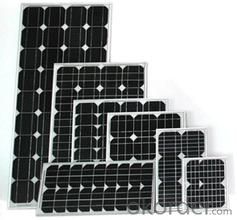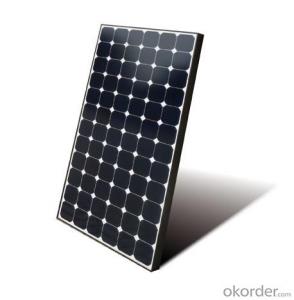Poly Solar Panel 80W A Grade with 12 Years Warranty
- Loading Port:
- Shanghai
- Payment Terms:
- TT OR LC
- Min Order Qty:
- 100 watt
- Supply Capability:
- 1000 watt/month
OKorder Service Pledge
OKorder Financial Service
You Might Also Like
Item specifice
Poly Solar Panel 80W A Grade with 12 Years Warranty
Production description
Solar power is the conversion of sunlight into electricity, either directly usingphotovoltaics (PV), or indirectly using concentrated solar power (CSP). Concentrated solar power systems use lenses or mirrors and tracking systems to focus a large area of sunlight into a small beam. Photovoltaics convert light into an electric currentusing the photovoltaic effect.[1]
The International Energy Agency projected in 2014 that under its "high renewables" scenario, by 2050, solar photovoltaics and concentrated solar power would contribute about 16 and 11 percent, respectively, of the worldwide electricity consumption, and solar would be the world's largest source of electricity. Most solar installations would be in China and India.[2]
It may also use a solar tracking system to improve the system's overall performance and include an integrated battery solution, as prices for storage devices are expected to decline. Strictly speaking, a solar arrayonly encompasses the ensemble of solar panels, the visible part of the PV system, and does not include all the other hardware, often summarized as balance of system (BOS). Moreover, PV systems convert light directly into electricity and shouldn't be confused with other technologies, such as concentrated solar power or solar thermal, used for heating and cooling.

Application
Commercial
Industrial
Residential
Product Feature
12 years quality warranty 25 years performance output.
Free for less than 5 pcs sample requirement
Free to replace or repair or refund if products fail to conform to the PI requirement.
Packaging
28pcs into carton 2carton into pallets 28pallets into a 40ft container
Delivery
After 25 days for manufacturered goods as soon as we received full payment.
After 10 days for stock goods as soon as we received full payment.
- Q:What do the solar cell suppliers provide once we purchase the order from the solar cells from them.
- There is a technical term called turnkey project, which is somehow the solar cell suppliers will provide more than selling the solar cells to you.
- Q:Can solar cells be used for portable devices?
- Yes, solar cells can be used for portable devices. They are increasingly being integrated into various portable devices such as smartphones, tablets, and wearable technology. Solar cells in portable devices can harness sunlight to charge the device's battery, providing a sustainable and convenient power source on the go.
- Q:How do solar cells perform in regions with frequent thunderstorms?
- Solar cells perform less efficiently in regions with frequent thunderstorms. Thunderstorms often bring heavy cloud cover and reduced sunlight, which significantly impacts the generation of solar energy. Additionally, the presence of lightning poses a risk to the solar panels themselves, potentially damaging or destroying them. Therefore, regions with frequent thunderstorms may not be ideal for solar energy production.
- Q:How do solar cells generate electricity at night?
- Solar cells do not generate electricity at night because they rely on sunlight to produce an electric current. During the night, there is no sunlight available for the solar cells to convert into electricity.
- Q:What is the lifespan of a solar cell?
- The lifespan of a solar cell can vary depending on various factors, but on average, solar cells have a lifespan of around 25 to 30 years. However, with proper maintenance and care, solar cells can even last longer, sometimes up to 40 years or more.
- Q:What is the impact of solar cells on reducing energy poverty?
- Solar cells have a significant impact on reducing energy poverty by providing access to electricity in remote areas that are not connected to the grid. They offer a reliable and sustainable source of power, enabling households to meet their basic energy needs and improve their quality of life. Additionally, solar cells reduce dependence on expensive and polluting fossil fuels, making energy more affordable and environmentally friendly for those living in poverty.
- Q:How do solar cells perform in desert environments?
- Solar cells perform exceptionally well in desert environments due to the abundance of sunlight and high temperatures. The vast open spaces and lack of cloud cover allow solar panels to receive maximum exposure to sunlight, resulting in higher energy production. Additionally, the dry and arid conditions in deserts help reduce dust and dirt accumulation on panels, ensuring optimal performance and efficiency.
- Q:How do solar cells perform in different geographic locations?
- Solar cells perform differently in different geographic locations due to variations in sunlight intensity and weather conditions. Locations closer to the equator typically receive more direct sunlight and have higher solar cell performance, while locations farther from the equator or with frequent cloud cover may have lower performance. Factors such as temperature, humidity, and air pollution can also affect the efficiency and lifespan of solar cells. Overall, solar cells can still generate electricity in various geographic locations, but the amount of energy produced may vary.
- Q:Can solar cells be used in aviation or aerospace applications?
- Yes, solar cells can be used in aviation or aerospace applications. Solar cells are commonly used in satellites to generate electricity from sunlight. They can also be used in unmanned aerial vehicles (UAVs) or drones to power their systems and extend their flight time. Additionally, some experimental aircraft have integrated solar panels to supplement their power needs.
- Q:Can solar cells be used in public transportation?
- Yes, solar cells can be used in public transportation. Solar panels can be installed on the roofs of buses, trains, and trams to generate electricity from sunlight. This renewable energy can be used to power various systems in public transportation, such as lighting, air conditioning, and even charging onboard devices. Additionally, solar cells can also be used to charge electric vehicles used in public transportation, reducing reliance on fossil fuels and contributing to a more sustainable transportation system.
1. Manufacturer Overview |
|
|---|---|
| Location | |
| Year Established | |
| Annual Output Value | |
| Main Markets | |
| Company Certifications | |
2. Manufacturer Certificates |
|
|---|---|
| a) Certification Name | |
| Range | |
| Reference | |
| Validity Period | |
3. Manufacturer Capability |
|
|---|---|
| a)Trade Capacity | |
| Nearest Port | |
| Export Percentage | |
| No.of Employees in Trade Department | |
| Language Spoken: | |
| b)Factory Information | |
| Factory Size: | |
| No. of Production Lines | |
| Contract Manufacturing | |
| Product Price Range | |
Send your message to us
Poly Solar Panel 80W A Grade with 12 Years Warranty
- Loading Port:
- Shanghai
- Payment Terms:
- TT OR LC
- Min Order Qty:
- 100 watt
- Supply Capability:
- 1000 watt/month
OKorder Service Pledge
OKorder Financial Service
Similar products
New products
Hot products
Related keywords



























